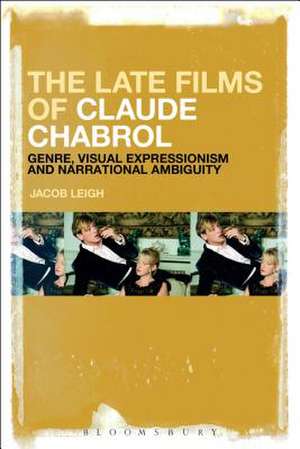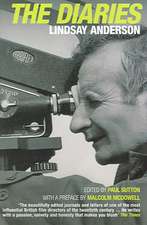The Late Films of Claude Chabrol: Genre, Visual Expressionism and Narrational Ambiguity
Autor Jacob Leighen Limba Engleză Paperback – 17 apr 2019
| Toate formatele și edițiile | Preț | Express |
|---|---|---|
| Paperback (1) | 229.59 lei 6-8 săpt. | |
| Bloomsbury Publishing – 17 apr 2019 | 229.59 lei 6-8 săpt. | |
| Hardback (1) | 714.92 lei 6-8 săpt. | |
| Bloomsbury Publishing – 18 oct 2017 | 714.92 lei 6-8 săpt. |
Preț: 229.59 lei
Preț vechi: 296.46 lei
-23% Nou
Puncte Express: 344
Preț estimativ în valută:
43.94€ • 45.70$ • 36.27£
43.94€ • 45.70$ • 36.27£
Carte tipărită la comandă
Livrare economică 15-29 aprilie
Preluare comenzi: 021 569.72.76
Specificații
ISBN-13: 9781501351976
ISBN-10: 1501351974
Pagini: 208
Ilustrații: 15 bw illus
Dimensiuni: 152 x 229 x 15 mm
Greutate: 0.29 kg
Editura: Bloomsbury Publishing
Colecția Bloomsbury Academic
Locul publicării:New York, United States
ISBN-10: 1501351974
Pagini: 208
Ilustrații: 15 bw illus
Dimensiuni: 152 x 229 x 15 mm
Greutate: 0.29 kg
Editura: Bloomsbury Publishing
Colecția Bloomsbury Academic
Locul publicării:New York, United States
Caracteristici
Contributes
to
studies
of
the
French
new
wave,
film
authorship,
critical
studies
of
film
style,
genre
studies
of
crime
fiction
and
cultural
studies
of
French
cinema
Notă biografică
Jacob
Leighis
Lecturer
in
the
Department
of
Media
Arts
at
Royal
Holloway,
University
of
London,
UK.
He
is
the
author
ofThe
Cinema
of
Ken
Loach:
Art
in
the
Service
of
the
People(2002),Reading
Rohmer,
Close-Up
02(2007),
andThe
Cinema
of
Eric
Rohmer:
Irony,
Imagination
and
the
Social
World(2012).
Cuprins
Introduction1.La
Cérémonie(1995):
Diary
of
a
Chambermaid2.Rien
ne
va
plus(1997):
Preparation
Meets
Opportunity
3.Au
Cour
du
mensonge(1999):
The
Fabric
of
Vision
4.Merci
pour
le
chocolat(2000):
Cause
and
Effect5.La
Fleur
du
mal(2003):
Keeping
it
in
the
Family
6.La
Demoiselle
d'honneur(2004):
Criss-Cross,
Motives
and
Murder7.L'Ivresse
du
pouvoir(2006):
Not
Following
the
Rules
of
the
Game
8.La
Fille
coupée
en
deux(2007):
Killing
the
Beast
9.Bellamy(2009):
More
than
Meets
the
EyeConclusionNotesBibliography
Index
Recenzii
Delving
into
Claude
Chabrol's
last
nine
films
with
an
entomologist's
loop,
Jacob
Leigh
provides
close
and
clever
readings
of
Chabrolian
codes,
contradictions
and
cunning
as
he
convincingly
argues
for
an
expression
of
late
style.
This book is the first in any language to take the full measure of Claude Chabrol's unique achievement as a filmmaker. Jacob Leigh brings together all the Chabrolian elements: humour and tragedy, involvement and distance, extreme stylisation and everyday detail, irony and critique. An indispensable companion to a rich body of work.
In this insightful and meticulous volume, Jacob Leigh provides an astute and authoritative account of a somewhat overlooked period in Chabrol's filmmaking career. Combining precise analysis with eloquent critical enquiry, this book will be indispensable to devotees of this director, of French film, and of contemporary cinema studies.
This is an elegant, eloquent and vital contribution to our understanding and appreciation of Chabrol's films. It also adds to scholarship on notions of late style, and guides the reader back to the director's work through sensitive interpretations.
A rich appreciation of Claude Chabrol illuminating with great sensitivity and detail the careful complexities of the director's late films. Leigh articulates the intricacies of Chabrol's style with great skill, providing a meticulous understanding of his sophisticated and playful construction of fictional worlds that challenge the viewer through stylised form and uncomfortable ambivalence. Essential reading for anyone interested in Chabrol, French cinema at the turn of the 21st Century or the contemporary development of melodrama, this book further highlights the value of an aesthetic understanding for our engagement with film.
This book is the first in any language to take the full measure of Claude Chabrol's unique achievement as a filmmaker. Jacob Leigh brings together all the Chabrolian elements: humour and tragedy, involvement and distance, extreme stylisation and everyday detail, irony and critique. An indispensable companion to a rich body of work.
In this insightful and meticulous volume, Jacob Leigh provides an astute and authoritative account of a somewhat overlooked period in Chabrol's filmmaking career. Combining precise analysis with eloquent critical enquiry, this book will be indispensable to devotees of this director, of French film, and of contemporary cinema studies.
This is an elegant, eloquent and vital contribution to our understanding and appreciation of Chabrol's films. It also adds to scholarship on notions of late style, and guides the reader back to the director's work through sensitive interpretations.
A rich appreciation of Claude Chabrol illuminating with great sensitivity and detail the careful complexities of the director's late films. Leigh articulates the intricacies of Chabrol's style with great skill, providing a meticulous understanding of his sophisticated and playful construction of fictional worlds that challenge the viewer through stylised form and uncomfortable ambivalence. Essential reading for anyone interested in Chabrol, French cinema at the turn of the 21st Century or the contemporary development of melodrama, this book further highlights the value of an aesthetic understanding for our engagement with film.










